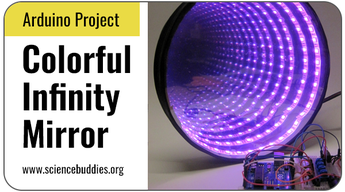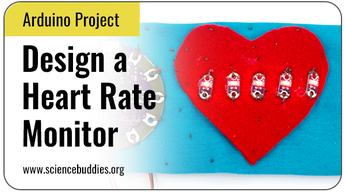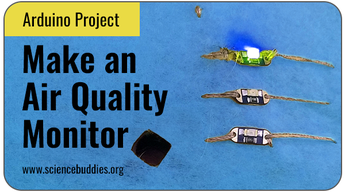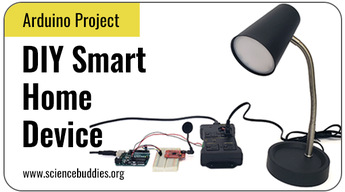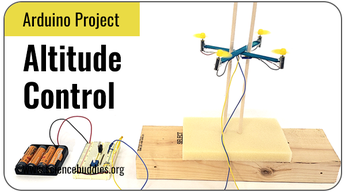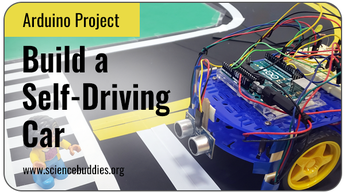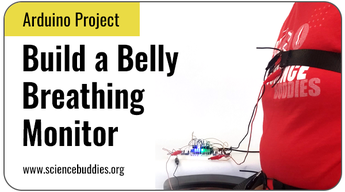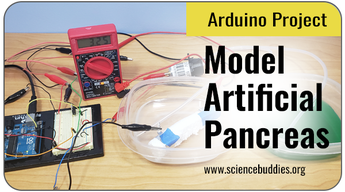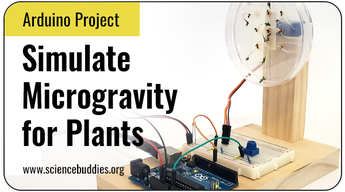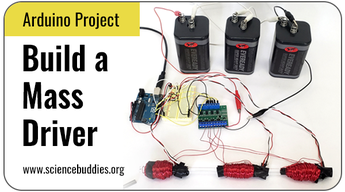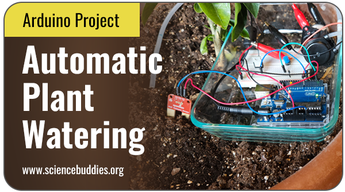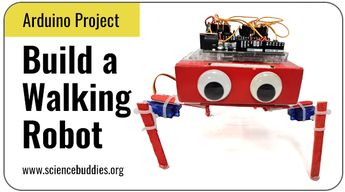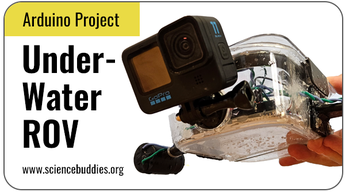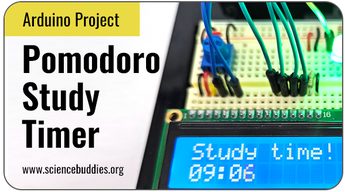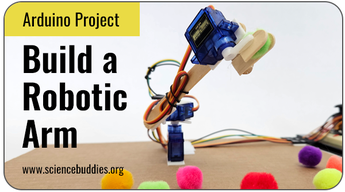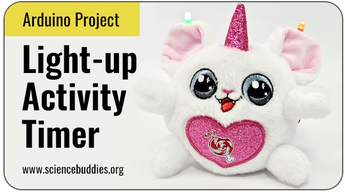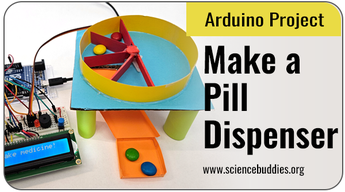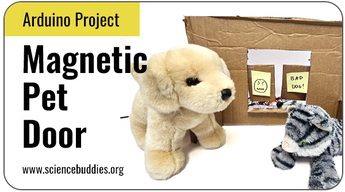Arduino Science Projects
Use Arduino to combine circuits and programming for a range of cutting-edge physical computing science projects.
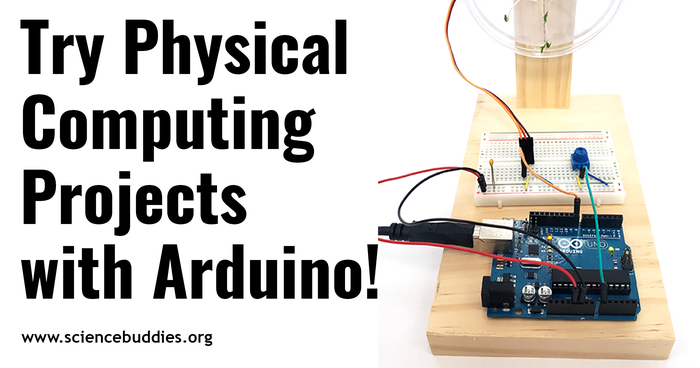
Use Arduino to Add Coding to Electronics Projects
The Arduino UNO is a microcontroller board that makes it easy for students to get started with physical computing. Unlike programming or coding projects that involve writing programs that run on a computer, physical computing (also called embedded computing) involves adding programming to circuit-based projects, like electronics and robotics. A microcontroller makes it easy to prototype circuits and programs. Often used to connect with sensors, lights, and motors, a microcontroller only runs one program at a time and is usually used to program a specific function or behavior, like turning an LED on or off or changing color or brightness based on set parameters or sensor-based data. Many of the devices and appliances we use everyday have embedded microcontrollers.
The How to Use an Arduino is available as a tutorial to help students get started working with Arduino.
Now available! A new Electronics Kit for Arduino is now available for students working on electronics, coding, and physical computing projects using Arduino. (See the "Materials" section for each project for a complete list of materials required.)
Arduino Science Projects!
Featured Arduino Projects
- Build an infinity mirror: after building an infinity mirror using LEDs and mirrors, add an Arduino to program the color of the LEDs used in this mesmerizing "endless tunnel" optical illusion.
- Design a heart monitor: design, build, and program a custom heart rate monitor that fits individual needs. Students will use the engineering design process to determine the best approach to making this device based on the intended use and design criteria. (For other wearables electronics projects, see 8 Wearables Science Projects.)
- Make a wearable air quality monitor: use sewn circuits, a TinyLily mini processor board, and Ardunio programming to design a wearable air quality sensor to monitor and alert when particle pollution in the air is dangerously high. (For a guided activity, see Make a wearable air quality sensor.)
- Build a smart home device with voice control: explore the use of speech recognition technology in smart home and AI devices by building a voice-controlled lamp.
- Explore altitude control with a mini drone: after building the basic DIY popsicle stick mini drone, add a simple circuit and an Arduino to investigate altitude control. (For a series of activities you can do with the basic mini drone, see Drone Science Projects with a DIY Popsicle Stick Drone. The DIY Mini Drone Kit has the parts needed to build the basic mini drone. Additional parts are required to integrate Arduino and test features in the subsequent projects.)
- Program a self-driving car: explore the cutting-edge science behind autonomous vehicles by combining a BlueBot robotics project with Arduino programming. (For additional projects you can do with the BlueBot kit, including several that use Arduino, see 10+ Robotics Projects with the BlueBot Kit.)
- Train people to belly breathe: build a breathing monitor that can help train people to engage in healthy belly (diaphragmatic) breathing.
- Create a model artificial pancreas: set up a model artificial pancreas to explore what is involved in the feedback loop required to keep blood glucose within a healthy range in people with insulin-dependent diabetes.
- Grow plants in microgravity with a clinostat: build a clinostat and compare plant growth in regular gravity and simulated microgravity. Because a clinostat rotates continuously, plants can't easily tell which way is "down." How does this affect their growth?
- Build a Model Mass Driver: build a mass driver (also called an electromagnetic catapult, space gun, or coil gun) and experiment to see how it can be used to launch objects at high speeds. This approach could be used, for example, to launch heavy materials into space for building a space station.
- Build a Circuit to Automatically Water Your Plants: build a circuit to automatically water a plant based on readings from a soil moisture sensor.
- Build an Arduino Walking Robot: build a quadruped walking robot.
- Build a Remotely Operated Vehicle (ROV) for Underwater Exploration: design and build a small underwater ROV that can be tested in a bathtub, pool, or nearby body of water.
- Make a Pomodoro Study Clock: make and program a Pomodoro study timer using an Arduino, LEDs, and an LCD screen. The study timer can be customized for different intervals of focus and rest.
- Build an RC Boat: build an untethered, radio-controlled (RC) boat using an Arduino and a plastic food storage container.
- Build a Robotic Arm: design and build a robotic arm that can perform a specific task. The project demonstrates a robotic arm with three degrees of freedom, one to rotate the arm horizontally, one to rotate the arm vertically, and one to control the gripper.
- Build a Light-Up Activity Timer: convert a stuffed animal into a light-up activity timer that you can activate with a press of an embedded force sensor.
- Make an Automatic Pill Dispenser: make an automated medication dispenser that can follow a programmed scheduled to dispense pills at varying times of the day.
- Build a Magnetic Pet Door: use servo motors and reed switches to build an automatic pet door that works with a magnetic collar tag to let some things in and keep other things out.
How to Do Your First Arduino Project!
For students getting started with Arduino, the How to Use an Arduino tutorial provides a series of videos that teach the fundamentals of working with Arduino, starting with the basic "setup" (the video shown above) and progressing step-by-step through additional things to connect, try, and troubleshoot. For example, the second video guides students in setting up the circuit and writing a program to blink an external LED.
The Arduino tutorial introduces students to writing and uploading programs, building simple circuits, and interfacing with inputs and outputs like buttons and LEDs. After working through the basics, students can progress to using Arduino in projects like the ones highlighted above.
Arduino Resources for Educators
The Introduction to Arduino lesson plan is available for introducing Arduino in a classroom or group setting. This lesson will teach your students the basics of working with an Arduino: writing and uploading programs, building simple circuits, and interfacing with inputs and outputs like buttons and LEDs. This sets the stage for more advanced projects like building robots, drones, voice-controlled appliances, and more.)
These physical computing lessons guide building and programming activities:
Arduino-based Physical Computing in Action
The following STEM videos demonstrate some of the projects highlighted above:
Related Resources
For additional resources to explore computer science, electronics, and maker projects, see the following:
- 18 Science Lessons to Teach Circuits
- 18 Next-Level Makerspace STEM Projects
- 10+ Robotics Projects with the BlueBot Kit
- 8 Wearables Science Projects
- 25+ Coding Projects for Beginners and Beyond
- Browse all projects that use Arduino
Categories:
You Might Also Enjoy These Related Posts:
- Teach Genetics and Heredity with Free STEM Lessons & Activities - Genetics Science Projects
- Star Wars Projects for May the 4th Be With You Science
- 25+ Earth Day Science Experiments and Activities
- Arduino Science Projects and Physical Computing
- Spring Science Projects: 26 Science Experiments for Spring
- 25+ Robotics Projects, Lessons, and Activities
- March Madness Basketball Science Projects: Sports Science Experiments
- 15 Density Science Experiments


